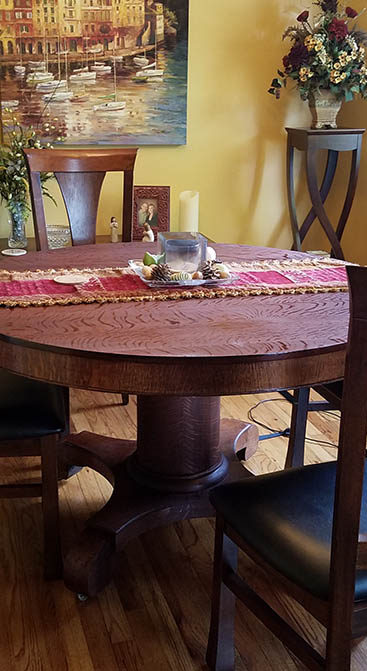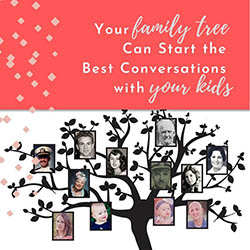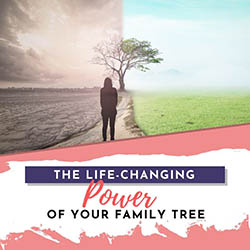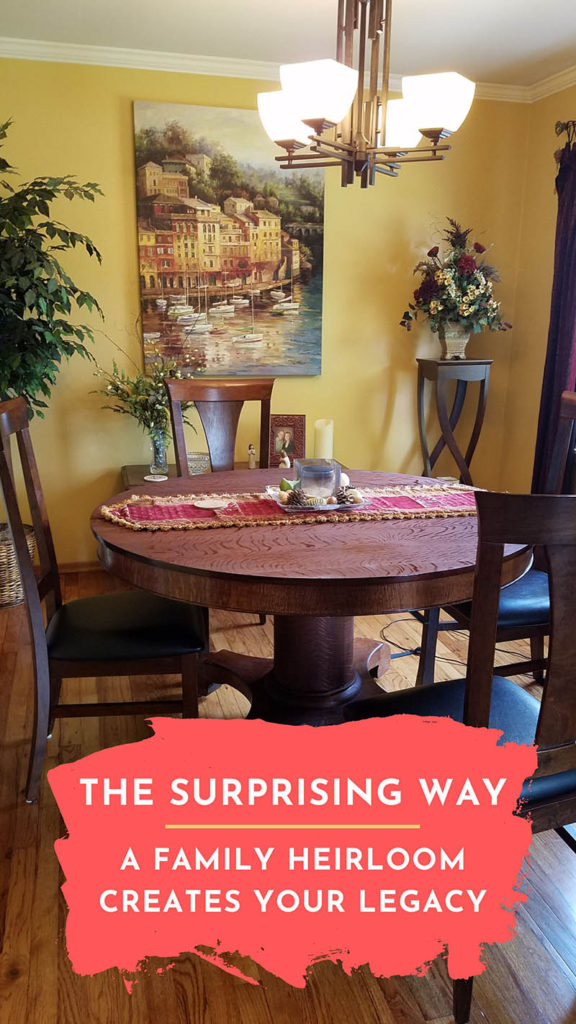
I was a bit surprised when I heard that “everyone wanted the table.”
I mean, it had sat in my husband’s grandmother’s basement playroom for as long as I’ve been part of the family. And pretty much only kids went down there, using the table to jump off, as barriers during play sword fights, and for other not-so-gentle pursuits.
The table was nicked and scratched and more than a little wobbly.
If I’d ever thought about it, and I don’t think I ever did, I would have guessed the table would go to a thrift store.
But when time came to divide grandma’s possessions, this table was on everyone’s list.
And that seemed strange.
The enthralling history of a coveted family heirloom
No one knows exactly where the table came from.
As far back as anyone can remember, the table belonged to Grandma and Grandpa Holmes.
Grandma Thelma and Grandpa Cy Holmes are my husband’s great-grandparents. Things might get a little confusing here, so let’s start with a small family tree showing the players in this table game:
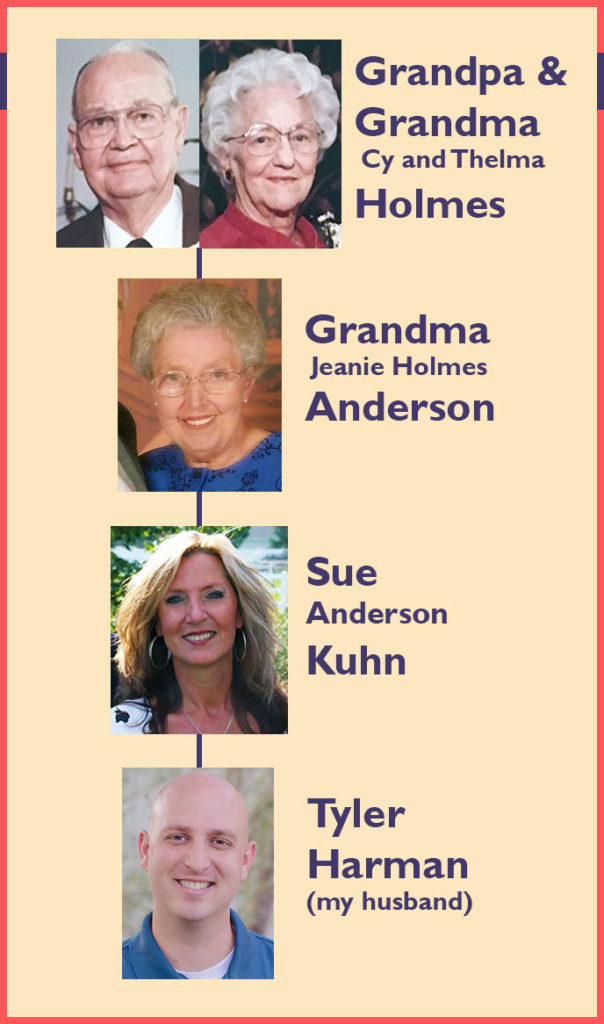
The table at the center of so much interest is a Tyden Locked Table made by the Hastings Table Company from Hastings, Michigan. We know that ’cause when we took it apart, we found the manufacturer’s logo.
A few Google searches later, we discovered this company was making these kinds of tables in the early 1900s. Here’s a newspaper ad from 1907:
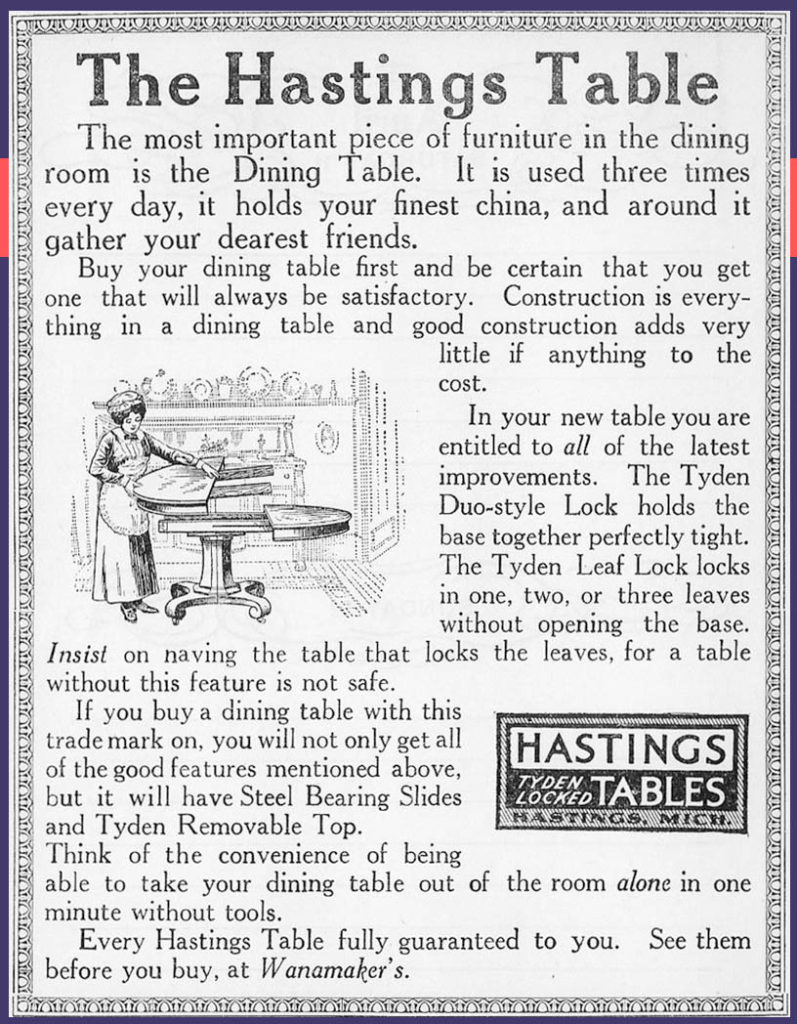
So, it seems like this table could be 100+ years old. But, strangely, Grandma and Grandpa Holmes began their family in the 1930s, so where and how did they get the table?
Well that’s a family mystery that no one seems to know the answer to. Maybe it was a wedding gift. Maybe it belonged to their parents. Sadly, at this moment, we just don’t know.
After Grandma and Grandpa Holmes died, this family heirloom went to their daughter Jeanie Holmes Anderson — who my husband and I fondly know as Grandma Anderson. And it’s at her home where I sat with my children (Grandma and Grandpa Holmes’s great-great-grandchildren) playing board games and piecing together puzzles.
And by that time, after years (decades even) in the basement playroom, the table was fairly beat up and seemed destined — IMHO — for Goodwill.
But, boy, was I wrong.
Centerpiece of the Holmes’s Family
As it turns out, when Grandma (Jeanie Holmes) Anderson passed away a couple years ago, everyone wanted that table.
And when I say everyone, I’m talking all 8 of Grandma Anderson’s kids, as well as Grandma Anderson’s 2 sisters and their children. In other words, most of Grandma and Grandpa Holmes’s children and grandchildren wanted the Holmes family heirloom.
Why?
Well, in one word: Memories.
In two words – Family Memories
The scratched, dented, wobbly playroom table was once the centerpiece of Holmes family gatherings for years upon years.
Cooking and baking were an important part of the Holmes family traditions. Grandma Holmes herself grew up in a family of cooks and bakers who boasted famous cinnamon bread, chocolates, and other family recipes.
“Baking and cooking was a sense of pride for my Grandma Holmes and her siblings, and it still is with me and my children,” explained Sue Kuhn, who is my husband’s mother and granddaughter of Grandma and Grandpa Holmes. “I feel like their dining-room table make that love of cooking central.”
Sue fondly recalls setting the table, adorned with ironed table cloths and freshly cut flowers, for Thanksgiving dinners at Grandma and Grandpa Holmes’s home.
“The table was a centerpiece of so many family gatherings with the Holmes’s,” Sue continued. “We would all gather at Grandma and Grandpa Holmes’s house every holiday for all the traditional baking and cooking. The table represents that family bond to everybody.”
A family heirloom that connects us to grandparents
When all was said and divided, Sue ended up with the table.
“I wanted this table because of my great love for Grandma and Grandpa Holmes,” Sue told me. “There isn’t any way to explain how much I loved them. When my children were small, we lived close to Grandma and Grandpa Holmes. My kids would climb their trees while I’d sit with Grandma and rub her hands and just tell her how much I loved her.”
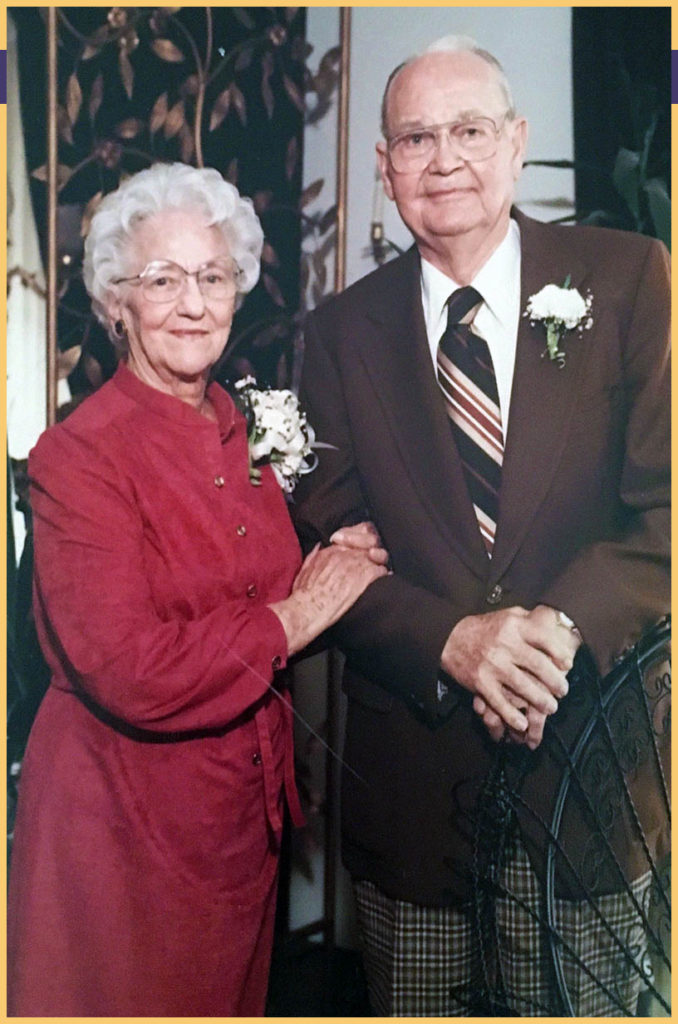
So, having their table in her home represents and helps Sue continue to feel that bond with them.
“There’s something about having a tangible object that gives a sense of the history and genealogy that I’m tied to,” Sue explains. “This table makes my ancestors not just names on a page.”
The other reason Sue wanted the table is that she loves restoring furniture.
Refinishing the table was a must. But why?
Sue knew immediately that that she would refinish the table.
In fact, if she’d had no intention or time to refinish it, she wouldn’t have taken the table.
“I wanted to be able to use the table on a daily basis,” Sue said. But in its post-playroom condition, it wasn’t a formal-dining-room kind of table.
It took her a long time to get it right.
In fact, over the course of this 9-month project, Sue fully sanded down and refinished the family heirloom 3 (yes, THREE) times because on the first try the color was wrong and on the second try the finish got bubbles in it.
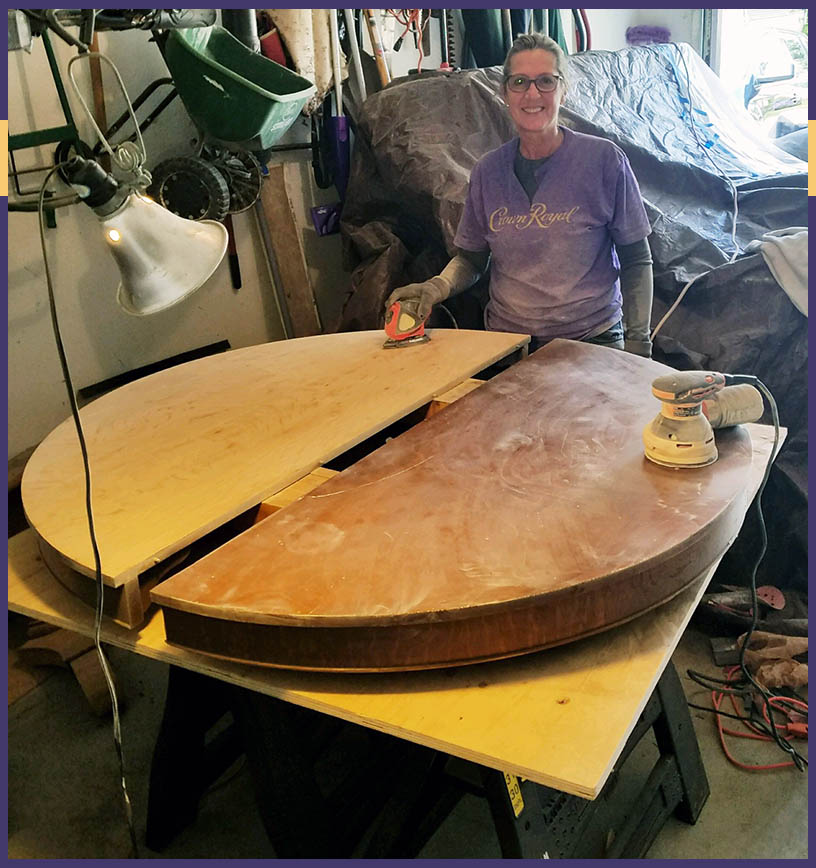
“Just OK wasn’t good enough for me,” Sue shared, “it had to be right.”
Why? Honor.
Honoring a memory
While working on the table, Sue “kept praying that I would do honor to my grandparents, to all the family who still love this table, and to the people who originally made the table.”
It was the least she could do for an object that represents that love she still has for her grandparents and the love they had for all their family.
Sue refinishing the Holmes family heirloom is also important to her siblings, aunts, and cousins.
“I’ve periodically shared pics of the refinishing process,” Sue said, “and everyone has been very supportive and loved seeing it restored. One brother told me, ‘I’m glad you got the table, Sue. If it had stayed with me, it would have never gotten refinished.’”
Preparing a legacy
Another of Sue’s refinishing prayers was that the table would continue to bring people around it.
And in Christmas 2019, that prayer was, in part, answered as many of her children, in-laws, and grandchildren gathered around the table, in various eating shifts, for Christmas dinner.
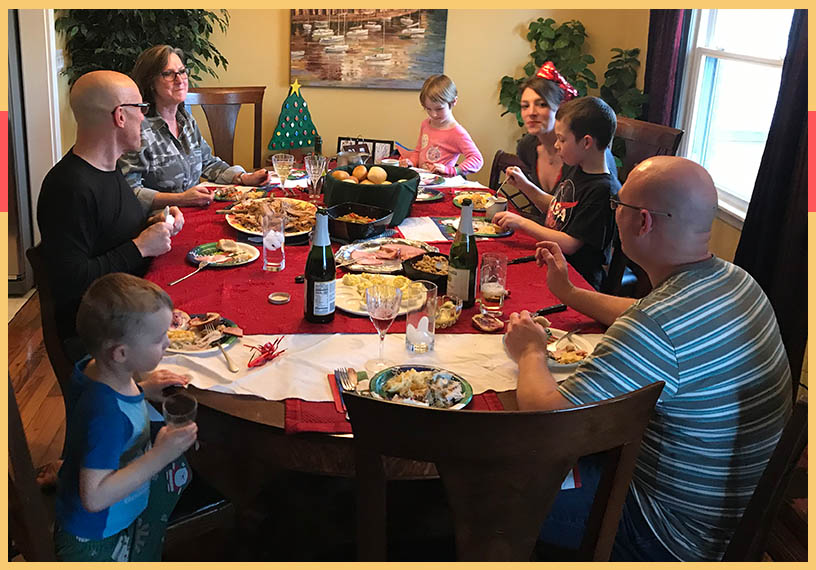
“I don’t even know if I could put into words what it meant to me to have so many of my children gathered around this table for Christmas,” Sue shared. “There are a lot of holidays with just me and Bret, so it was extra special to have nearly all my children here for the first Christmas since the table’s been refinished.”
Sue believes her work has given the table another 100 years of life and use.
“I would hope that one of my children will take this table, respect it, and love it the way I do,” she said. “If the table lasts another 100 years, maybe someone can then refinish it again. Family things like this are more than just objects.”
Sue’s feelings about honoring the past and creating a legacy remind me of this beautiful video called “A Piano’s Purpose”:
For Sue, refinishing her grandparents’ table makes family history, tradition, and legacy central. A way of honoring her heritage and bringing it full circle.
Discovering a multi-generation family trait
Another discovery from refinishing this table is realizing that woodworking is a family trait across several generations.
Woodworking – especially building and/or refinishing furniture — is a hobby of Sue’s and several of her brothers. One brother is a woodworker by trade and has been able to restore the wood details of several historic buildings at Utah State University.
Even Sue’s son Tyler (who is my husband) shares this woodworking love. For Christmas a couple years ago, he built me this farm-style table. From scratch. He’s pretty darn amazing (I just gotta throw that out there).
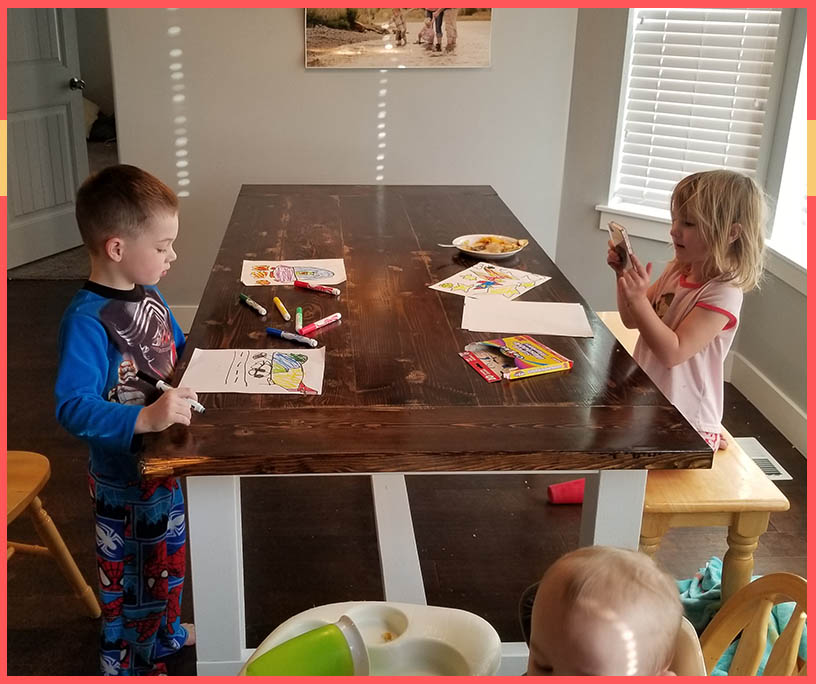
“For me,” Sue said, “restoring furniture offers honor and connection – to people, to history, even to a growing tree.”
And it’s been interesting to realize this common woodworking trait running through her family.
It’s not the family heirloom, it’s the connection
The finished table sits in Sue’s dining room. She walks by it multiple times daily. It’s where she works every day.
“Every day I look at the table and think, ‘It’s beautiful, I love it,’” Sue told me. “There’s a daily touch point for me of the table and what it represents. It’s not just a table, it’s the relationship, the love I have with Grandma and Grandpa Holmes.”
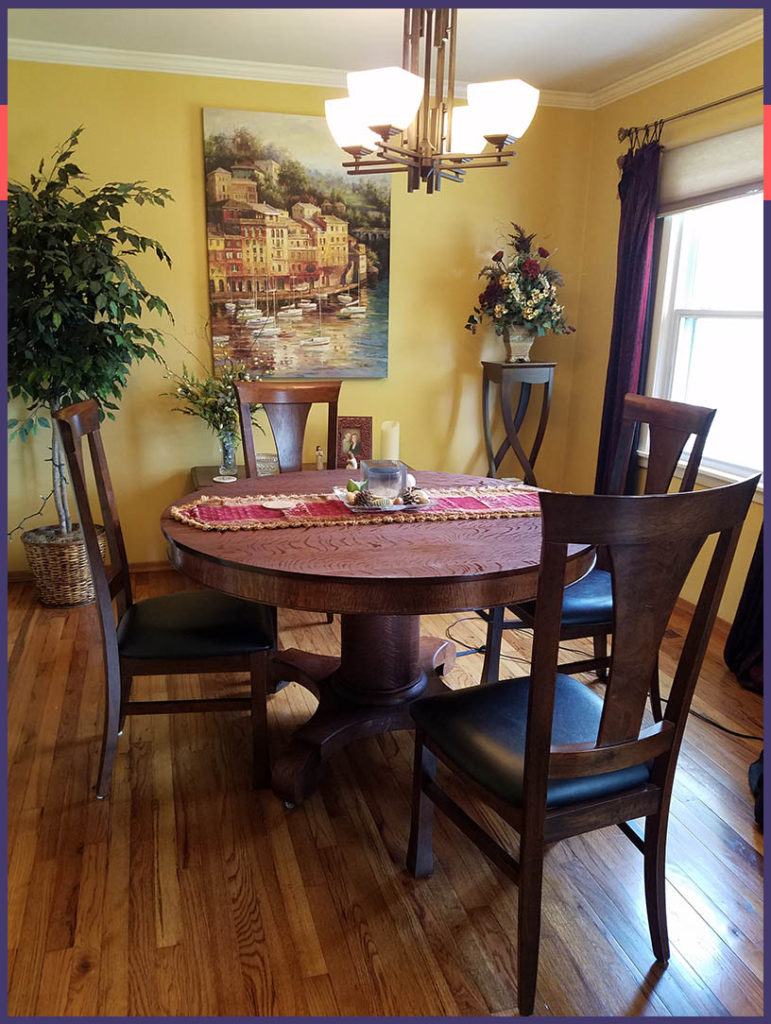
Her extended family’s reaction to the refinished family heirloom has reinforced the importance of restoring the table to honor the relationship everyone had with Grandma and Grandpa Holmes.
“I just know Grandma and Grandpa would be so thrilled if they could come and sit around the table,” Sue said.
And she believes that, in some way, Grandma and Grandpa Holmes do come and sit around that table. Perhaps, or maybe especially, during family gatherings. “I didn’t do it just for me, the family can continue to enjoy and take pride in this table.”
So you want to restore a family heirloom…
If you’ve got a family heirloom or object you’re thinking of restoring or just want to keep safe for generations to come, Sue has a few thoughts for you:
- Before beginning the restoration project, discover the history of the piece — whether it’s a family heirloom or even just a historical piece. What personal stories and history go along with the furniture or object?
- Find your emotional connection to the piece. Finding and recording the stories and history — from the first step — will likely help you find an emotional connection to the object. And that emotional connection is what will make the restoring process unforgettable.
- Leave some of the imperfections. Sue refinished an old hutch that had bread-pan burn marks on it. After trying and retrying to sand away the burn marks, someone told her to leave them because they’re part of the hutch’s history. Today that hutch sits in Sue’s kitchen, and she thinks of the women some 100 years ago cooling bread on that hutch.
Even more advice from heirloom experts
I attended a class at the 2020 RootsTech conference called “What Your Old Objects and Images Might Be Able to Tell You.” The presenters (who help run a RootsTech exhibit called “Heirloom Show and Tell”) suggested 5 questions to ask about, record, and keep with family heirlooms:
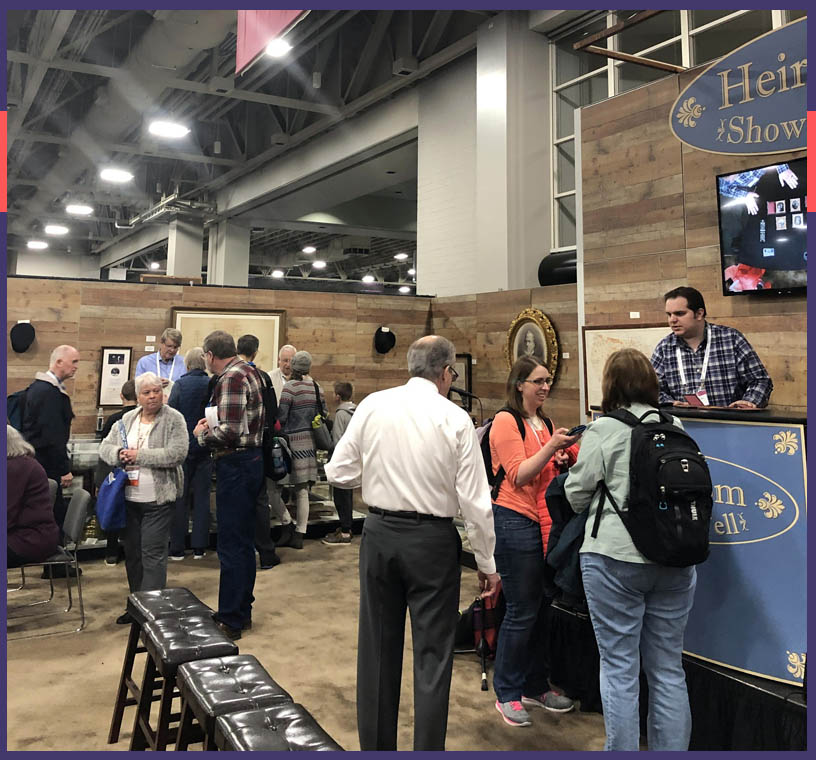
- Who did the object belong to? Include the full name of the individual.
- When did the person get the object? Include the exact date and place and even occasion (if known).
- Why did the person get the object? Perhaps it was a wedding gift, something grandpa made for grandma, or any number of other reasons.
- What are the special stories that go along with the item? As illustrated by this article, stories and connection are really what make the object valuable.
- What is the object’s monetary value? Maybe you don’t want to sell the object. But…knowing an object’s worth may keep children from sending the $20,000-value, first-edition of Pride and Prejudice to Goodwill. (Remember how I thought the table would end up at Goodwill? Yeah, good thing I wasn’t in charge of dividing up the estate…) eBay can be a good place to do valuations. Include the date and method of valuation.
Have you had similar experiences safeguarding or restoring a family heirloom? If so, I would love to hear about it in the comments below.
